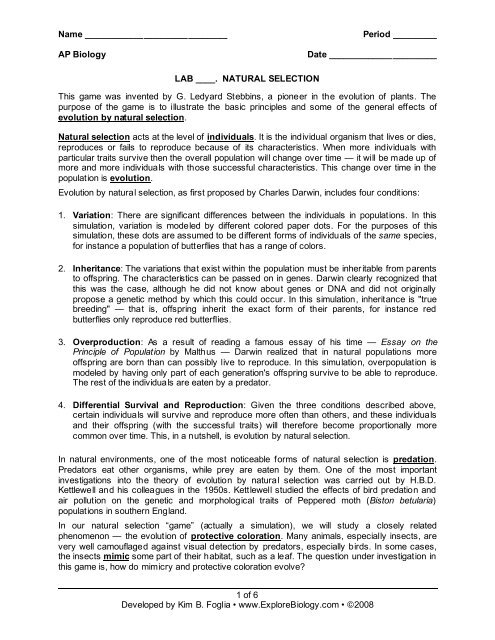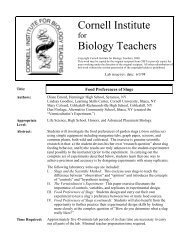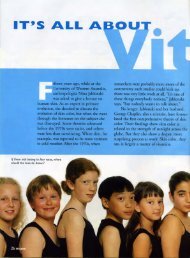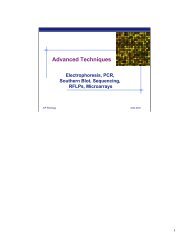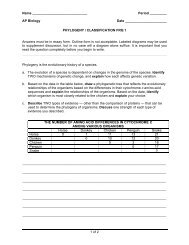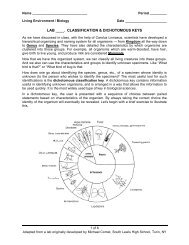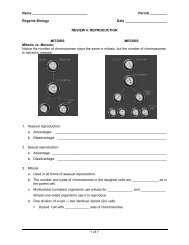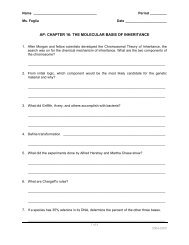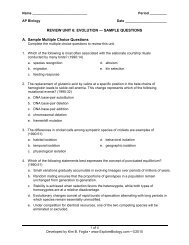Natural Selection of Butterflies - Explore Biology
Natural Selection of Butterflies - Explore Biology
Natural Selection of Butterflies - Explore Biology
Create successful ePaper yourself
Turn your PDF publications into a flip-book with our unique Google optimized e-Paper software.
Name _____________________________AP <strong>Biology</strong>Period _________Date ______________________LAB ____. NATURAL SELECTIONThis game was invented by G. Ledyard Stebbins, a pioneer in the evolution <strong>of</strong> plants. Thepurpose <strong>of</strong> the game is to illustrate the basic principles and some <strong>of</strong> the general effects <strong>of</strong>evolution by natural selection.<strong>Natural</strong> selection acts at the level <strong>of</strong> individuals. It is the individual organism that lives or dies,reproduces or fails to reproduce because <strong>of</strong> its characteristics. When more individuals withparticular traits survive then the overall population will change over time — it will be made up <strong>of</strong>more and more individuals with those successful characteristics. This change over time in thepopulation is evolution.Evolution by natural selection, as first proposed by Charles Darwin, includes four conditions:1. Variation: There are significant differences between the individuals in populations. In thissimulation, variation is modeled by different colored paper dots. For the purposes <strong>of</strong> thissimulation, these dots are assumed to be different forms <strong>of</strong> individuals <strong>of</strong> the same species,for instance a population <strong>of</strong> butterflies that has a range <strong>of</strong> colors.2. Inheritance: The variations that exist within the population must be inheritable from parentsto <strong>of</strong>fspring. The characteristics can be passed on in genes. Darwin clearly recognized thatthis was the case, although he did not know about genes or DNA and did not originallypropose a genetic method by which this could occur. In this simulation, inheritance is "truebreeding" — that is, <strong>of</strong>fspring inherit the exact form <strong>of</strong> their parents, for instance redbutterflies only reproduce red butterflies.3. Overproduction: As a result <strong>of</strong> reading a famous essay <strong>of</strong> his time — Essay on thePrinciple <strong>of</strong> Population by Malthus — Darwin realized that in natural populations more<strong>of</strong>fspring are born than can possibly live to reproduce. In this simulation, overpopulation ismodeled by having only part <strong>of</strong> each generation's <strong>of</strong>fspring survive to be able to reproduce.The rest <strong>of</strong> the individuals are eaten by a predator.4. Differential Survival and Reproduction: Given the three conditions described above,certain individuals will survive and reproduce more <strong>of</strong>ten than others, and these individualsand their <strong>of</strong>fspring (with the successful traits) will therefore become proportionally morecommon over time. This, in a nutshell, is evolution by natural selection.In natural environments, one <strong>of</strong> the most noticeable forms <strong>of</strong> natural selection is predation.Predators eat other organisms, while prey are eaten by them. One <strong>of</strong> the most importantinvestigations into the theory <strong>of</strong> evolution by natural selection was carried out by H.B.D.Kettlewell and his colleagues in the 1950s. Kettlewell studied the effects <strong>of</strong> bird predation andair pollution on the genetic and morphological traits <strong>of</strong> Peppered moth (Biston betularia)populations in southern England.In our natural selection “game” (actually a simulation), we will study a closely relatedphenomenon — the evolution <strong>of</strong> protective coloration. Many animals, especially insects, arevery well camouflaged against visual detection by predators, especially birds. In some cases,the insects mimic some part <strong>of</strong> their habitat, such as a leaf. The question under investigation inthis game is, how do mimicry and protective coloration evolve?1 <strong>of</strong> 6Developed by Kim B. Foglia • www.<strong>Explore</strong><strong>Biology</strong>.com • ©2008
Name _____________________________AP <strong>Biology</strong>HOW TO PLAY THE GAMEIn this game/simulation, paper dots <strong>of</strong> different colors represent butterflies. The different colorsrepresent different color variations within one species <strong>of</strong> butterfly. These different colorvariations are the result <strong>of</strong> purely random genetic mutations and genetic recombination withinthis single species. To model the random character <strong>of</strong> these variations, we will begin with equalnumbers <strong>of</strong> each color butterfly (each color dot) at the start <strong>of</strong> the game. It is assumed that thedifferent colors are inherited genetically.Step 1: Divide the class into two-person teams. Each team will begin with a different, coloredcloth "environment" (~16” x 16” square). One person should be designated as the first“Butterfly Predator”. The Butterfly Predator should not be allowed to see what goes onin Step 2, in order that her/his "predation" remain unbiased. The other team membersets up the environment <strong>of</strong> butterflies.Step 2: The other team member should count out four butterflies (dots) <strong>of</strong> each color — this isthe starting population for your environment — Generation #1. Record that in the datatable. This same person should then randomly scatter these butterflies on the clothenvironment. Since there are five colors, there will be a total <strong>of</strong> twenty butterflies inthe environment to start with. This is the maximum population <strong>of</strong> butterflies yourenvironment can support — it’s the carrying capacity <strong>of</strong> your environment.Step 3: The Butterfly Predator should now capture ten butterflies by picking up 10 dots asquickly as possible, one dot at a time. Also, it is important that the Butterfly Predatorbreak eye contact with the ground after each pick (look away from the cloth and thendown again before each hunt). Be sure to pick the very first butterfly that you see!After all, time is energy (you're hunting, remember!), and so you can't afford to wasteeither time or energy by being too picky. Put your "eaten" butterflies (dots) away; theyhave been removed from the population and do not get to reproduce.Step 4: Now collect your surviving butterflies (dots) from the cloth. Be sure to get all <strong>of</strong> them.There must be 10 surviving butterflies.Step 5: Each surviving butterfly (dot) now reproduces. For each surviving butterfly, add one dot<strong>of</strong> the same color from your reserve — your butterflies have now reproduced! So nowyou will have 20 butterflies again. This is Generation #2. Count your butterflies andrecord the number <strong>of</strong> each color variant for Generation #2 only in the ButterflyPredator’s data table.Notice that there may not necessarily be the same number <strong>of</strong> each color any more —natural selection has been at work in your population <strong>of</strong> individuals!Step 6: For all the next rounds (Generations #2-#6), the Butterfly Predator remains the sameperson. The other team member should again randomly scatter the new generation <strong>of</strong>20 butterflies in the environment and repeat the above steps. Continue until you havecompleted all generations. Record the data only in the Butterfly Predator’s data table.Step 7: Team members should switch roles and complete the new Butterfly Predator’s datatable. In this way, you have replicated your experiment with a different predator butusing the same environment.2 <strong>of</strong> 6Developed by Kim B. Foglia • www.<strong>Explore</strong><strong>Biology</strong>.com • ©2008
Name _____________________________AP <strong>Biology</strong>DATA COLLECTION1. After you have chosen your “environment” cloth, write downyour prediction <strong>of</strong> which color morph <strong>of</strong> this species <strong>of</strong>butterfly will better be able to survive in this environment _____________________________2. Record your raw data in the table below:number <strong>of</strong> butterflies entering generation6Color variants 1 2 3 4 5(final)redyellowbluegreenwhiteTOTALS 20 20 20 20 20 203. Calculate the frequency <strong>of</strong> each butterfly color and record in the table below:frequency <strong>of</strong> color variants entering generation6Color variants 1 2 3 4 5(final)redyellowbluegreenwhiteTOTALS 100 100 100 100 100 1004. Graph your calculated frequencies using a bar graph/histogram.3 <strong>of</strong> 6Developed by Kim B. Foglia • www.<strong>Explore</strong><strong>Biology</strong>.com • ©2008
Name _____________________________AP <strong>Biology</strong>c. How many <strong>of</strong> this color did you start with in Generation #1? ________________________d. What was the frequency <strong>of</strong> this color at the start <strong>of</strong> Generation #1? __________________e. How many <strong>of</strong> this color did you end up with in Generation #6? ______________________f. What was the frequency <strong>of</strong> this color at the start <strong>of</strong> Generation #6? __________________g. Suggest a possible explanation <strong>of</strong> why this color was less fit in this environment._________________________________________________________________________________________________________________________________________________________________________________________________________________________________6. Separate from your specific environment used in this lab, consider the following"thought experiments" in natural selection— what outcome might you expect under thefollowing conditions described below.a. If the color differences were less distinct (ex. all butterflies were only shades <strong>of</strong> reds andoranges), would you expect similar results? Explain what you would expect and why._________________________________________________________________________________________________________________________________________________________________________________________________________________________________b. What if you had a population with all 5 colors again, but the red butterflies made the predatorvery ill; would you expect similar results? Explain what you would expect and why._________________________________________________________________________________________________________________________________________________________________________________________________________________________________c. What assumptions must you make about the predator’s abilities for your prediction to comeabout in the question above (7b)?_________________________________________________________________________________________________________________________________________________________________________________________________________________________________5 <strong>of</strong> 6Developed by Kim B. Foglia • www.<strong>Explore</strong><strong>Biology</strong>.com • ©2008
Name _____________________________AP <strong>Biology</strong>d. What if the red butterflies made the predator very ill and it learned to stay away fromthem, and there also was a new group <strong>of</strong> butterflies very similar in color (a close redorangecolor). What would happen to the red-orange butterflies? Explain your answer._________________________________________________________________________________________________________________________________________________________________________________________________________________________________e. Over the long term, what trait (ability) could be strongly selected for in the predatorpopulation in the situation <strong>of</strong> similar color variants proposed above (7d)?_________________________________________________________________________________________________________________________________________________________________________________________________________________________________f. In 7(e) you identified a trait (ability) that would strongly benefit the predator population.Does that mean the population will evolve that trait, since it is a “need” they have._________________________________________________________________________________________________________________________________________________________________________________________________________________________________7. Consider the results in this lab. Did any <strong>of</strong> the butterflies survive because they chose to bethe more fit color? Did any supernatural power design the surviving butterflies to be morefit? What did you learn about how evolution works from this lab?__________________________________________________________________________________________________________________________________________________________________________________________________________________________________________________________________________________________________________________________________________________________________________________________________________________________________________________________________8. Don’t forget to graph your calculated frequencies using a bar graph/histogram.6 <strong>of</strong> 6Developed by Kim B. Foglia • www.<strong>Explore</strong><strong>Biology</strong>.com • ©2008


